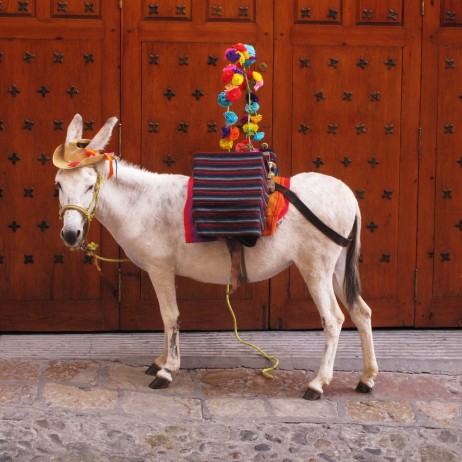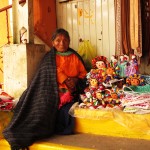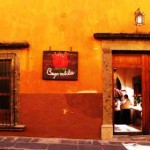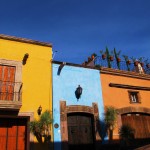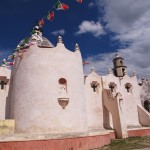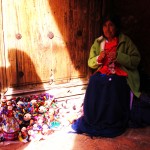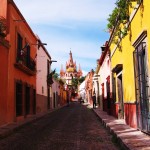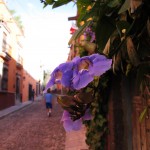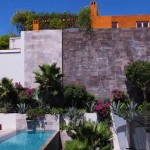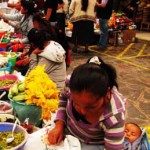San Miguel de Allende, Mexico
A Colorful, Cobblestone-Scored City in the Heart of Mexico
By Ashley M. Halligan
A cobblestone scored city, traversed by people the world over, San Miguel de Allende is a UNESCO World Heritage Site in the very interior core of Mexico — the heart of Mexico, as many deem it. San Miguel is a colorful escape, south of Mexico City in the state of Guanajuato, which reached its peak in the mid-18th century, following the discovery of silver in the nearby state of Zacatecas. Because of its prosperous beginning, the city is rich with Baroque and Neoclassical architecture as well as well-preserved buildings and mansions from the 17th and 18th centuries.
Following the city’s decline after the Mexican War of Independence, San Miguel was in danger of becoming a ghost town, but was thankfully salvaged by artists in the early 20th century who began numerous institutions of art and culture within its perimeters. This revived the city and afforded an economically promising future for tourism, becoming home to worldwide expatriates. Following World War II, many U.S. soldiers relocated to San Miguel as students studying under the G.I. Bill.
Today San Miguel’s streets are a blend of indigenous peoples, curious travelers and expatriates who’ve found a new place to call home, or a second home, in a city and culture vibrant with its international and historic inspiration. All of this is set on a typical Spanish Colonial backdrop with vivid colors lining the aforementioned cobblestone streets, bougainvilleas of all colors overgrowing the city’s walls and dropping petals along the streets’ stonework (after the region’s rainy season, that is). The aroma of typical street dishes like elote flourish — essentially roasted Mexican sweet corn with a mayonnaise, chili powder and Cojita cheese garnish, while the collective melodies of church bells linger throughout the narrow corridored roads. San Miguel is, after all, a church city with an enticing church on seemingly every corner, each with a history as unique as the city’s. Most well known is La Parroquia, the emblematic center of the main square, a salmon-hued neo-Gothic cathedral towering over the happenings of a typical day in San Miguel.
Alongside San Miguel’s traditional daily markets filled with authentic craftsmen and women selling silver goods, papier-mâché animals, ornate tapestries, local herbs and spices, hand-crafted leather goods and native cuisine like hand-pressed gorditas and corn tortillas, are walkable streets with endless stories to discover. With its cafes, outdoor tables, trail filled parks and a public library (La Biblioteca de San Miguel de Allende) with meandering courtyards and cozy rooms with bright wall murals, lined in dusty hardbacked books, San Miguel is a city with boundless beauty holding something to be discovered in its every, centuries-old nook.
Where to Stay:
Hotel Matilda (hotelmatilda.com)
Crossing the Colonial threshold into a minimalist and modern luxury hotel, Hotel Matilda lies just beyond a typical beet-shaded facade and is infused with a thoughtfully designed scape, incorporating an enviable art collection, a fascinating library in which the books have been craftily placed — backwards, an organic touch with trees growing through its common areas and a working combination of high-fashion and old world touches like the inviting sound of the entry’s fountain crafted from an upcycled old millstone.
If not for the beautifully appointed rooms, all unique with a tranquil ivory and cerulean theme, some with balconies overlooking the confetti colored rooftops of San Miguel, the spa alone is worth the stay. Hotel Matilda’s spa has adopted the age-old tradition of apothecary concoctions with old fashion mortar and pestles used to muddle random concoctions of locally sourced, organic ingredients. The tres leches exfoliating scrub and body wrap with organic milk, soymilk and vanilla is perhaps the most divine treatment on the planet. In addition to the on-premise spa, the hotel has opened an outdoor spa just outside of town called Spa En Vivo with outdoor massages tents, natural hot springs and a temazcal, a traditional Mesoamerican sweat lodge. Spa En Vivo overlooks the Mexican countryside and is an oasis for spring-side and fireside relaxation before or after chosen treatments.
The hotel’s restaurant, snugly aside its tranquil infinity pool offers a culinary adventure for those seeking innovative representations of regional dishes. The atmosphere is sophisticated and classy, boasting elements of Hotel Matilda’s expansive art collection and artfully crafted dishes made with ingredients from the hotel’s own organic farm. Meanwhile, the upstairs lounge and bar continues with the organic, gallery-esque theme serving contemporary cocktails and on weekends, a soundtrack heavy on party-inducing tracks by Pretty Lights and Gotan Project.
What to Eat:
El Manantial
This hole-in-the-wall (at the corner of Barranca and Huertes) is said to be the oldest cantina in San Miguel de Allende and serves an inexpensive array of octopus tostadas, mussels and a variety of regional tacos. Bugambilia (on Hidalgo) serves one of the region’s most traditional dishes, chiles en nogadas, a stuffed poblano chile with a walnut cream sauce.
Daytrips to Consider:
Atotonilco
Atotonilco is another UNESCO World Heritage Site, just minutes outside of San Miguel’s historical center and is an important pilgrimage site for pilgrims traveling from all over the continent. Atotonilco is a complex of churches built in the 1700s that were originally intended to offer Christian education and for housing spiritual exercise. Left wilting and abandoned until recently, the church is slowly undergoing restoration and holds a certain unexplainable mystique. Bright white against a blue sky, Atotonilco towers over the little village in which it resides with sleepy roads, handmade street food and wandering dogs. It’s a typical Mexican village with señors passing days on benches, smoking hand-rolled cigarettes and watching the quiet activity of day’s passed.
Cañada de la Virgen
This is a pre- Columbian archaeological site in the Mexican state of Guanajuato, again just a few miles (and a beautiful drive) from San Miguel de Allende. The site was just opened to the public in February 2011 and is still under excavation, making it a unique and still mysterious archaeological complex to visit. Believed to be of Toltec creation, Cañada de la Virgen was a pilgrimage site and a location for celestial observation. Consisting of multiple structures including a pyramid and several burial sites, visiting Cañada de la Virgen is eerie and time-warping, particularly given the climb of the pyramid’s steps to its top, overlooking flower-covered Mexican plains and multiple tombs across the property.

